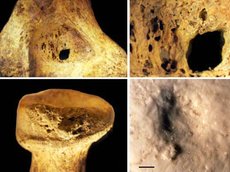Kennewick Man
|
|
Kennewick Man is the name for the remains of a prehistoric man found on a bank of the Columbia River near Kennewick, Washington, on July 28, 1996. The discovery of Kennewick Man was accidental; a pair of spectators at the yearly hydroplane races found his skull while swimming in the Columbia River. [1] (http://www.kennewick-man.com/kman/news/story/2888895p-2924726c.html)
The remains became embroiled in debates about the relationship between Native American religous rights and archaeology. Four Native American groups (the Nez Perce, Umatilla, Yakama, and Colville) claimed the remains as theirs, to be buried by traditional means. Only Umatillas continued further court proceeding but gave up before reaching the Supreme Court, thus preserving the bones for scientific examination. Efforts have moved to Congress to reclassify the bones as Native American by legislation, which would require they be released for burial.
| Contents |
Scientific significance
The remains were initially given to forensic anthropologists, who studied them until it was determined that they were of a man who lived approximately 9000 years ago. Both carbon dating (although unreliable in cases such as this due to contamination) and a Clovis spearhead lodged in the hip of the skeleton pointed to a very old date. A controversy emerged when an analysis of the bones' features suggested "caucasoid" descent. However, this is nothing uncommon for Native Americans, since research has shown some groups have caucasic genes. A reconstruction of the skull revealed a person similar in appearance to Patrick Stewart.
The history of the colonization of North America by humans, once thought to have occurred fundamentally by migration across the Bering Strait land bridge during the most recent ice age, has increasingly been revealed by archaeological evidence to be much more complex; multiple waves of humans have apparently made the journey, via different means and from different regions. Kennewick Man may be evidence of such a colonization wave.
Ownership controversy
According to the Native American Graves Protection and Repatriation Act (NAGPRA) signed into law by President George H. W. Bush in 1990, if human remains are found on federal lands and their cultural affiliation can be established, the bones must be returned to the affiliated tribe. The Umatilla tribe of Native Americans requested custody of the remains, wanting to bury them according to tribal tradition. However, their claim was contested by researchers hoping to study the remains; if Kennewick Man has no direct connection to modern-day native tribes, then NAGPRA should not apply.
The Umatilla argue that their origin beliefs say that their people have been present on the lands since the dawn of time, so a government holding that Kennewick Man is not Native American is tantamount to the government's rejecting their beliefs.
On February 4, 2004, the 9th U.S. Circuit Court of Appeals panel rejected the appeal of the Umatilla, Colville, Yakama, Nez Perce and other tribes on the grounds that they had not given any proof of kinship. The tribes dropped their lawsuits for custody.
In April 2005, United States Senator John McCain introduced an amendment to NAGPRA which would change the definition of "Native American" from being that which "is indigenous to the United States" to "is or was indigenous to the United States." By that definition, Kennewick Man would be Native American, whether or not any link to a contemporary tribe could be found. A hearing on this amendment has been scheduled for June 14, 2005.
The remains are now at the Burke Museum at the University of Washington.
Current research
In early July 2005, scientists from around the country will convene in Seattle for about two weeks to study the remains. [2] (http://www.tri-cityherald.com/tch/local/v-rss/story/6626748p-6512469c.html)
Further reading
- Ancient Encounters: Kennewick Man & the First Americans, James C. Chatters, Simon and Schuster, hardcover, 304 pages, ISBN 068485936X
- Unweaving the Rainbow: Science, Delusion and the Appetite for Wonder by Richard Dawkins ISBN 0618056734
External links
- National Park Service AEP: Kennewick Man (http://www.cr.nps.gov/aad/kennewick/index.htm) (all text and images from this site are in the public domain)
- http://www.kennewick-man.com
- http://archaeology.miningco.com/blkennewick.htm
- http://www.mnh.si.edu/arctic/html/kennewick_man.html
- Burke Museum (http://www.washington.edu/burkemuseum/kman/default.htm)
- http://www.friendsofpast.org Friends of America's Past - source for court documents; calendar of extraordinary events related to this case
- http://www.umatilla.nsn.us/ancient.html The Umatilla Tribe's official position

